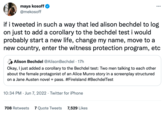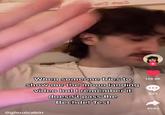Bechdel Test
This submission is currently being researched & evaluated!
You can help confirm this entry by contributing facts, media, and other evidence of notability and mutation.
About
The Bechdel Test, also known as Mo Movie Measure and The Bechdel-Wallace Test,[25] is a method used in media criticism to gauge the degree of representation and development of female characters within a work of fiction, and therefore, any gender bias against women that may be present in it. The test simply asks whether the fictional work in question features "at least two women who talk to each other about something other than a man."
Origin
The concept was first introduced by author Alison Bechdel in a strip from her 1985 comic collection Dykes to Watch Out For, which credits her friend Liz Wallace for coming up with the idea (shown below).

In the strip, two women are seen walking past a movie theater as one explains to the other a set of three conditions that must be fulfilled for her to enjoy a film (shown below). The character then goes on to mention that the last film she had seen to pass this test was the 1979 sci-fi action film Alien, which was released six years prior to the publication of the comic strip.
"One, it has to have a least two women in it, who, two talk to each other, about, three, something besides a man."
The earliest online instance of the comic was uploaded on August 16th, 2005, by Bechdel via her Flickr[22] and Blogspot[23] accounts. As of March 2014, the Flickr image has garnered more than 230,000 views.
Spread
Throughout the latter half of the 2000s, the Bechdel test became discussed by media critics, feminist bloggers and scholars, applying its scope to a wide range of fictional works across different genres and mediums, from films[6][8] and sci-fi literature[20] to video games[21] and TV shows. On June 30th, 2008, Jennifer Kesler published a post titled "Why film schools teach screenwriters not to pass the Bechdel test" on the film blog The Hathor Legacy.[7] On May 9th, 2009, first entry for The Bechdel Test on Urban Dictionary[1] was entered by user AutumnDevi.
On December 7th, 2009, Anita Sarkeesian uploaded an episode titled "The Bechdel Test for Women in Movies" to her video blog Feminist Frequency, in which she defines the standard and lists many films that don't pass the test such as Bruno, Ghostbusters, and Clerks. As of March 2014, the video has gained over 730,000 views.
On April 11th, 2010, bechdeltest.com[3] was created with a list of movies that pass the test, as well as others that only partially meet the requirements but not all.[5] In 2013, a handful of movie theaters in Sweden began issuing "A" ratings to movies that passed the test.[2]
Criticism
On November 13th, 2013, IndieCritic[10] ran a post titled "Does It Matter If the Bechdel Test "Fails" Feminist Films?" that suggests the test can let films that do not treat women well slide, while ignoring female dominated films like Sex and the City: 2. On January 7th, 2014, Slate[9] published a post titled "The Bechdel Test Sets the Bar Too Low. Let's Write a New One" that discussed the tests shortcomings.
Derivatives
Finkbeiner Test
On March 5th, 2013, science writer Christie Aschwanden published an article titled "The Finkbeiner Test" on the online science magazine Double X Science.[11] In it she explained her colleague Ann Finkbeiner wanted to write a profile of a female scientist without focusing or even mentioning the fact she is female. She goes on to outline seven things a piece would have to avoid mentioning in order to not focus on a female scientist's gender, including:
"* The fact that she’s a woman
* Her husband’s job
* Her child care arrangements
* How she nurtures her underlings
* How she was taken aback by the competitiveness in her field
* How she’s such a role model for other women
* How she’s the “first woman to…”
Aschwanden dubbed this the "Finkbeiner Test." Within the month the test had been covered by Netorama[12], the Columbia Journalism Review[13], and ScienceBlogs.[14]
Russo Test
On August 21st, 2013 GLADD[14] ( which originally stood for the Gay & Lesbian Alliance Against Defamation) published its "First annual Studio Responsibility Index finds lack of substantial LGBT characters in mainstream films" which introduced the Russo Test, a set of standards a film had to meet to be inclusive of LGBT characters. The test, named for Vito Russo, a film historian who was also one of the founders of GLAAD, consists of three standards for a film to meet including:
"1. The film contains a character that is identifiably lesbian, gay, bisexual, and/or transgender (LGBT).
2. That character must not be solely or predominantly defined by their sexual orientation or gender identity (i.e. the character is made up of the same sort of unique character traits commonly used to differentiate straight characters from one another).
3. The LGBT character must be tied into the plot in such a way that their removal would have a significant effect. Meaning they are not there to simply provide colorful commentary, paint urban authenticity, or (perhaps most commonly) set up a punchline; the character should matter."
Within the month Slash Film[15] published a list of films released in 2012 that passed the Russo test and Cinema Blend[16] covered the test as well.
The Rep Test
In February 2014, the Representation Project[17], an organization started in 2011 by film maker Jennifer Siebel Newsom whose website describes it as "a movement that uses film and media content to expose injustices created by gender stereotypes and to shift people’s consciousness towards change," released a set of guidelines for a film to meet called "The Representation Test."[18] It was released as a checklist with points awarded for positive, well rounded representation of men, women, ethnic minorities, and members of the LGBT community. Points are out of 23 possible, with anything above 11 earning the movie an "A" and zero points earning the film and "F." One of the possible points a film can be awarded is gained through passing the Bechdel test. In March 2014, the test was covered by culture site Take Part[19] and news site Raw Story.[24]

2022 Corollary
On June 6th, 2022, Hanna Rosin,[26] the chief of New York Magazine's podcasts division, posted a tweet criticizing the Hulu movie Fire Island (2022) for failing to pass the Bechdel test. The film, which revolves around a group of gay Asian-American men on vacation and is based off Jane Austen's novel Pride and Prejudice (1813) features one female character that Rosin labelled a "drab lesbian." Her tweet criticizing Fire Island gained 257 likes and 1,862 quote retweets, before it was deleted. Rosin's tweet thread apologizing for and screenshotting the deleted first tweet received 883 likes over the day after it was posted.

An online controversy quickly emerged around Rosin's take, with many criticizing her for posting it. Some also mocked those who didn't seem to understand the original Bechdel test, such as @capybaronness[27] (see below), whose tweet about its misuse gained over 74,000 likes over the course of two days.

On June 7th, Alison Bechdel[28] herself tweeted a "corollary" to the Bechdel test, specifically declaring that Fire Island met her requirements and passed. This tweet gained over 40,000 likes and over 5,000 retweets within a day after Bechdel posted it.

Bechdel's tweet inspired another round of mockery of Rosin, with many joking about Rosin's imagined response to the news. Maya Kosoff's tweet[29] about the topic gained over 7,500 likes in less than a day.

Search Interest
External References
[1] Urban Dictionary – The Bechdel Test
[2] The Guardian- Swedish cinemas take aim at gender bias with Bechdel test rating
[3] Bechdel Test – The Bechdel Test
[4] YouTube – feministfrequency
[5] Internic – Blechdeltest.com
[6] Total Film – 50 Greatest Films That Pass The Bechdel Test
[7] The Hathor Legacy – Why film schools teach screenwriters not to pass the Bechdel test
[8] Vocativ – Hollywood Movies With Strong Female Roles Make More Money
[9] Slate – Hollywood Movies With Strong Female Roles Make More Money
[10] Indie Wire – Does It Matter If the Bechdel Test "Fails" Feminist Films?
[11] Double X Science – The Finkbeiner Test
[12] Neatorama – The Finkbeiner Test
[13] Columbia Journalism Review – The Finkbeiner Test
[14] Science Blogs- Asking Questions and the “Finkbeiner Test”
[15] GLADD- First annual Studio Responsibility Index finds lack of substantial LGBT characters in mainstream films
[16] Cinema Blend- The Bechdel Test For Gay Characters
[17] The Representation Project- About
[18] The Representation Project- The Rep Test
[19] Take Apart- Rated W: This New Ratings System Tests Films on How They Depict Women
[20] Larvatus Prodeo – Setting Low Bars
[21] GiantBomb – Games that pass the Bechdel test
[24] Raw Story- New 20-question test grades how women are represented in movies
[25] The Mary Sue – Alison Bechdel Would Like You to Call It the “Bechdel-Wallace Test,” ThankYouVeryMuch
[26] Twitter – @HannaRosin
[27] Twitter – @capybaroness
[28] Twitter – @AlisonBechdel













Top Comments
rg57
Mar 19, 2014 at 01:13AM EDT
WhipperSnapper
Mar 18, 2014 at 09:13PM EDT